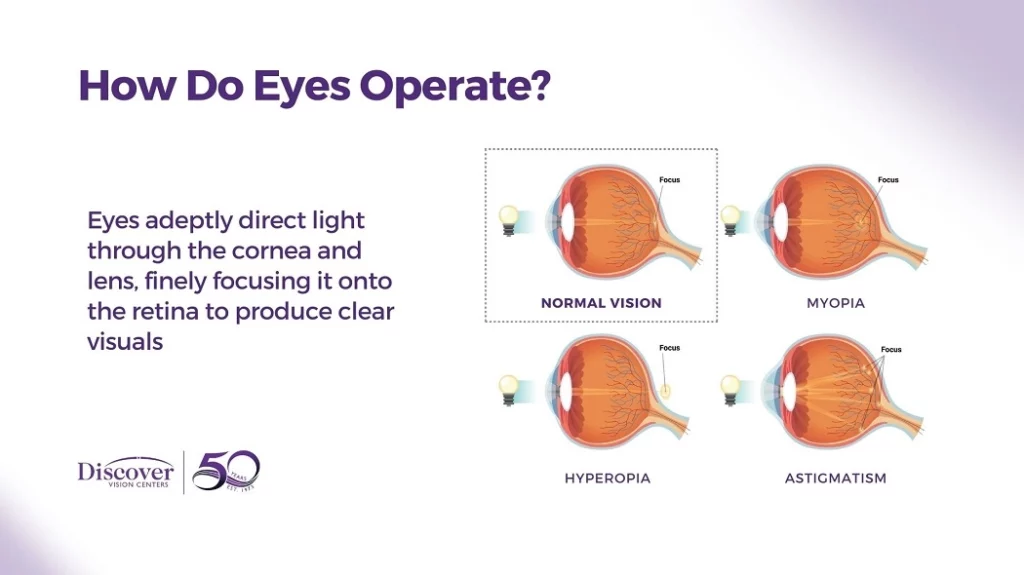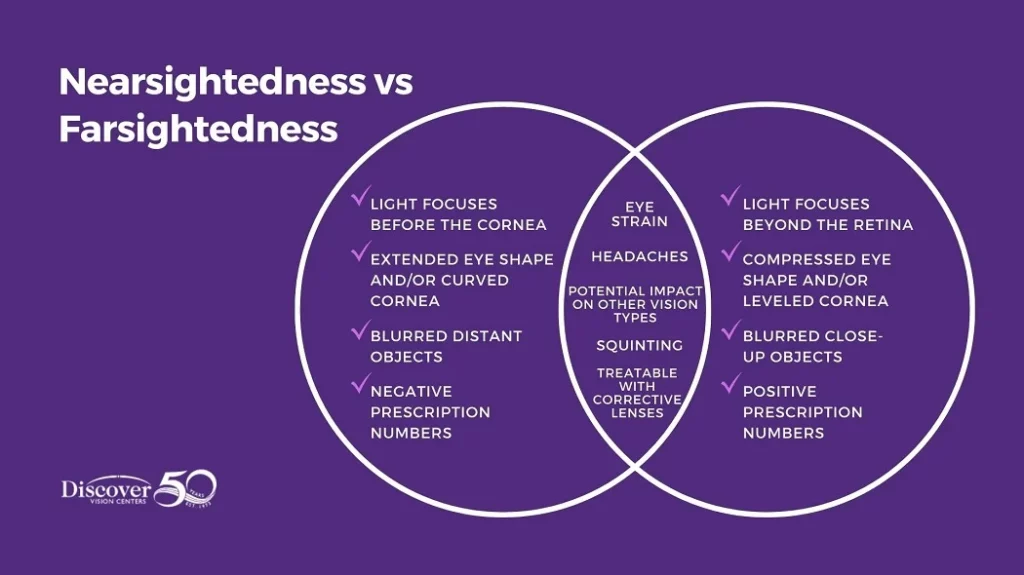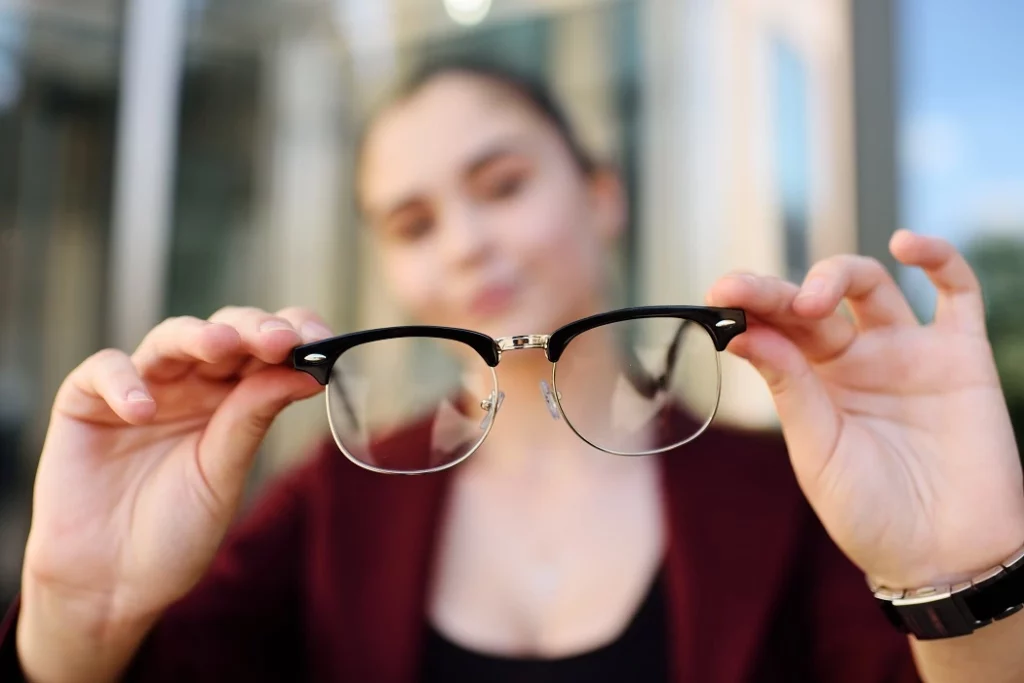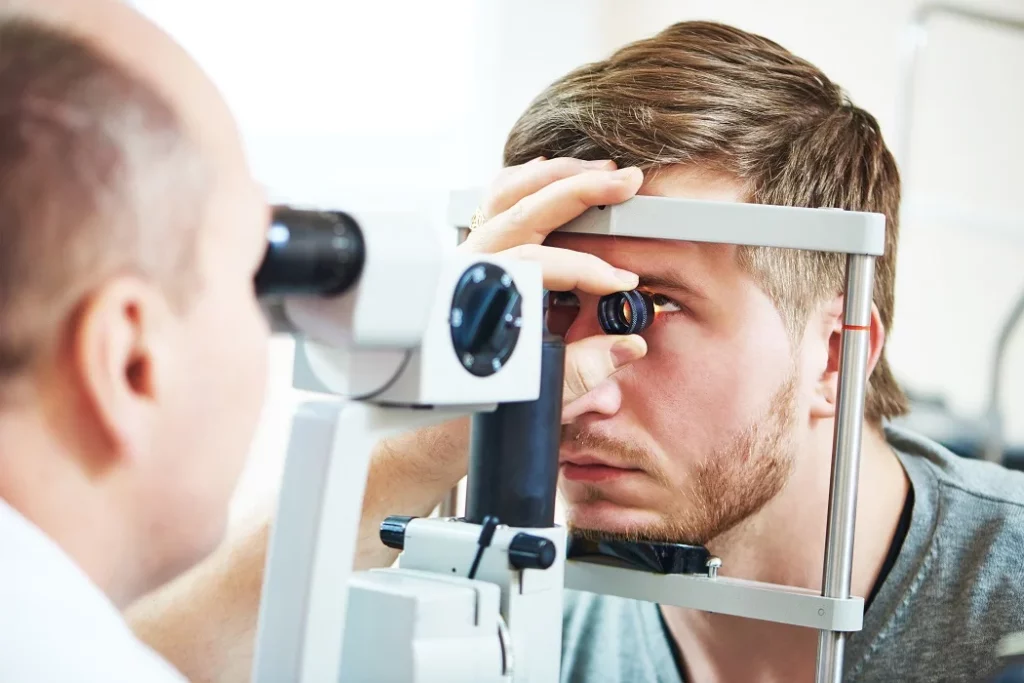
Updated: February 09, 2024

Understanding nearsightedness vs farsightedness is crucial in our visually-driven world. Millions of people navigate through their daily lives dealing with these issues, often unaware of the reasoning behind these frustrating impairments.
Dive into an in-depth guide, from root causes and symptoms to diagnostic procedures and treatment options with Discover Vision Centers, your informed resource for all things visual health.
Eyes are intricate organs that focus light to create visuals. When light rays enter the eye, they first travel through the cornea, a clear, curved surface at the front. The light then focuses through the lens, situated just behind the iris, ultimately making its way toward the retina at the back of the eye.
In an ideal scenario without refractive error, light focuses directly on the retina to achieve clear vision. The retina’s light-sensitive cells convert these light rays into messages, which are sent via the optic nerve to the brain, producing the images we see.
If a refractive error occurs, light focuses either in front of the retina or behind it which distorts how the image is perceived.

Nearsightedness is a condition that affects your ability to see distant objects. This is a key differentiator in the conversation around nearsightedness vs farsightedness.
In those who are nearsighted, the light focuses in front of the retina rather than on it due to the eyeball being slightly elongated or the cornea having a steeper curve. Refractive errors like this can result in images of distant objects appearing blurry while those up close remain clear. This highlights a stark contrast especially when discussing nearsightedness vs its counterpoint, farsightedness.
Symptoms commonly associated with nearsightedness or being nearsighted include blurry vision when viewing objects far away, a need to squint to see objects more clearly, headaches, and eye fatigue. This typically plays out with difficulties in activities like recognizing faces or reading signs from a distance.
Children and adults are susceptible to myopia, although most cases are diagnosed in younger children and adolescents as their eyes undergo significant shape changes during growth. Environmental factors such as extended close-up work on computers or mobile devices are also considered contributing risk factors. Additionally, it’s been shown that not getting enough natural sunlight can lead to nearsightedness.

On the other hand, farsightedness results in clear far vision while compromising the clarity of near vision.
Unlike nearsightedness, those who are farsighted experience light focusing behind the retina due to a shorter eyeball or a less curved cornea. This refractive error impacts the ability to focus properly on close objects, making activities like reading or sewing more visually demanding.
When nearsightedness and farsightedness are compared, symptoms can appear to be opposites. For example, farsighted individuals may notice blurry vision predominantly while attempting to focus on objects up close, coupled with eye strain, aching around the eyes, and potential headaches after long periods of near-focused activities.
Much like nearsightedness, farsightedness can also be diagnosed in both children and adults. Genetic factors heavily influence its onset — this condition often passes through generations. Strabismus, or crossed eyes, and other visual developmental issues may develop in children if hyperopia is left undiagnosed and uncorrected.

Astigmatism is a prevalent vision problem that stems from an asymmetry in the eye’s shape.
In the realm of astigmatism, an asymmetric curve in the lens or the cornea reshapes the path of light entering the eye, which alters its refraction onto the retina. Unlike myopia and hyperopia, where nearsighted vs farsighted positions blur at specific distances, astigmatism generally impacts clarity and causes blurring across all distances.
When considering nearsighted vs farsighted vs astigmatism, astigmatism doesn’t only come from genetic or environmental factors but also potentially as the result of eye surgeries or injuries. It adds a distinct complexity to how we perceive and address vision problems. Astigmatism, and occur with either nearsightedness or farsightedness.
Everyone’s sight experiences are unique and various factors that change throughout the day can cause changes. Normal vision is typically described as having 20/20 vision, as determined through a visual acuity test. In other words, having 20/20 vision means you can perceive at 20 feet what should ideally be seen at that distance. If your vision is 20/50, for example, you must be 20 feet away to see what a person with standard vision can see from 50 feet away.
If you experience daily blurry vision, you’ll want to visit an eye care professional.
If you are not seeing well, seeking a professional consultation is recommended. This is the fastest way to improve your eyesight and help you best experience the world around you!

Addressing nearsighted or farsighted visual challenges not only enhances your ability to see the world but also improves the safety of daily activities like driving and utilizing machinery.
It’s important to get treatment that’s right for you. For many facing difficulties in both nearsightedness and farsightedness, using corrective lenses, such as glasses, becomes the first line in managing discrepancies in both your distance and close-up vision. The flexibility to wear glasses whenever you need to gives you flexibility in managing your vision.
If one is intolerant of contact lenses or does not like glasses, then surgical options can be considered. Procedures like LASIK, SMILE eye surgery, Refractive Lens Exchange, and PRK are known for offering a more permanent solution to rectifying the eye’s focusing ability, improving visual clarity, and minimizing the need for glasses or contacts.
Your journey to a clear vision starts today! At Discover Vision, we’re here to guide you every step of the way with our experienced eye doctors and top-notch laser vision correction options, stylish glasses, and contact lens solutions. Our team is dedicated to helping you see life more clearly.
Choose your path and let’s navigate your vision journey together. Connect with us and see how we can help you to ensure you see every moment with utmost clarity.